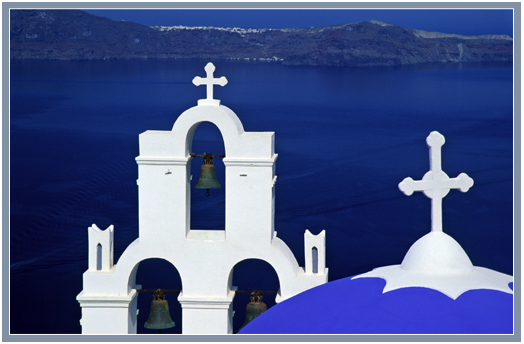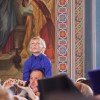Source: Ukrainian Orthodoxy
It seems that Christmas decorations come out earlier each year.
The fact is that the “Christmas spirit” is the best thing that has ever happened to consumer society. It is equated with the unending desire to buy new and more sophisticated things. Even charitable organizations are caught up by all this hype. “Give a kid a Christmas” as one local radio station advertises, really means to allow others to participate in the bliss of consumer heaven . . .
Perhaps this is an exaggeration. It is not meant to be. We have all heard the phrase, “Put Christ back into Christmas.” But just how do we go about doing that?
Christmas itself comes from the pre-Conquest (and therefore Orthodox) Old English term that is a composite of the Calendar feast in honour of which the daily Liturgy was celebrated i.e. “Christ-Mass.”
In the Old Sarum Rite, there was “Andermas” for St Andrew’s Day. Others included: Martinmas, Michaelmas, Ladymas (for the Mother of God), Candlemas (Feast of the Meeting of St Simeon or “Purification”), Johnmas or, in Ireland, Seanmas (and thus the name, “Seamus”) and so on.
Christmas itself became a composite of a Christian holy-day and the pagan feast associated with December 25th, as is well known. Originally, the Church celebrated the Nativity of Christ, the Three Kings and Epiphany all on the same day, January 6th. Only the Armenian Apostolic Orthodox Church continues to celebrate Christmas on this day, however, otherwise known as “Armenian Christmas.”

The Church “baptized” many of the traditions associated around December 25th and appointed the Nativity of Our Lord to be celebrated then. Much of what we know to be Christmas traditions are actually carry-overs from the Celtic pagan Druidic period, especially things like Mistletoe and the hanging of greenery on windows and chimneys (to prevent evil spirits from coming into the house).
Other traditions were added later, such as outdoor Christmas lights. These come from the Penal Period in Ireland’s history when Catholic priests, hunted by Cromwell’s soldiers, would recognize a candle in the window as a safe haven. When asked by the soldiers what the significance of the candle was, the people would simply say, “We are lighting Joseph and Mary’s way to Bethlehem.”
Christmas in our western society refers to a specific culture that grips it from early November until after January. It involves practices, symbols and behaviours that are specific to it and that don’t really depend on Christian faith for their ongoing existence at all. Indeed, Christian faith has become an optional item during the Christmas celebrations.
People of other faiths don’t find the celebration of Christmas offensive to their religious systems at all, it would seem.
There was a time when it wasn’t “politically correct” to say “Merry Christmas” at least in the part of the world in which I live. (The term is also a corruption of the Old English “Merrieg Christmas” or “Holy Christmas.”)
People in government offices weren’t allowed to place small Nativity sets on their desks etc.
Now this is all the rage, however.
Many Hindus in India participate in the cultural celebration of Christmas with decorated trees and gifts. Many Jewish friends also have decorated trees sometimes called “Chanukah Bushes.” (There is no such thing in Judaism, however.)
One Jewish lady wrote a letter to the local papers here to say that she loves the “warmth of Christmas” and has always observed it.
Now, cultural sharing is a wonderful thing. I have a Ukrainian Jewish relative and we have, as a family, celebrated Chanukah with the lighting of the candles and other ceremonies. This relative loves Eastern icons of the Saints of the Old Testament as well!
The point is that the Christmas of western culture has become so independent of spiritual significance that one is at a loss to see in it anything of religious value whatever.
It is true that Christmas is what one makes of it. The suggestion is made here that the celebration of Orthodox Nativity in accordance with the Julian Calendar is one of the best ways to “make” of this holiday something truly wonderful and deeply Christian.
At the outset, there are some very important religious differences in approach to the mystery of the Incarnation of Jesus Christ between East and West.
For the West, the main point concerning the Incarnation of God the Word is in God’s “humility” in assuming human nature.
Under strong influence of Augustine of Hippo and later of the Calvinists, the doctrine of “Theosis” has all but been practically forgotten in the West.
This is why western pictures of Jesus show Him as a human being only, without the spiritualized and deified features of Orthodox Iconography.
For the Orthodox Church, however, the main point of celebration of the Incarnation of Christ is the “lifting up” of our nature in Christ, its redemption and glorification through Christ’s Life, Death and Resurrection.
As one Ukrainian Christmas carol puts it, (please excuse my loose translation):
“So as to unite Heaven with Earth,
Christ is Born – Let us glorify Him!”
In Orthodox Christianity, Christ’s Incarnation is already our Salvation. God assumes human flesh and His Divinity heals and transforms us.
Christ enters the waters of the River Jordan and, by His Presence in it, blesses and transforms it, making it a means of imparting Grace to humankind in the waters of Baptism. Christ is crucified and is buried. His presence in the Earth sanctifies it as well.
Anglican theology, it should be pointed out, has done, by far, a much better job of representing this Patristic view of the Incarnation than other western confessions. The Sarum Rite and Anglican theologians have always referred to the Theotokos as such, the “Bearer of God,” as an example.
The Incarnation of our Lord, God and Saviour, Jesus Christ, is of such magnitude that it really transforms the meaning of “religion” itself.
“Religo” means to “bind together.” In this sense, we speak of humankind seeking to be bound in a relationship with God through religion.
But in Christianity, God actually assumes our human nature. He is one with it. There is no separation or distance between us, thanks to our Lord Jesus Christ and His transforming power in our lives!
Salvation is mediated through the deified humanity of Christ, through His Church which is His Body. We are all called to share in that salvation through Grace and in that mediation to bring the message of Christ and His Gospel to the world.
God the Word becomes localized in space and time through assuming flesh from a Virgin, and we become heirs to Divine Opportunity with respect to Grace, salvation and personal transformation.
In the Orthodox celebration of the Nativity of Christ, the first three important days call to mind: The Birth of God Incarnate, the role of the Virgin Mary in mediating the Incarnation as the Bearer of God (second day) and the mediation of the martyrs as witnesses to Christ and His Gospel (St Stephen’s Day).
We can spend the rest of our lives meditating on these wonderful truths and on our divine calling to participate in them. Is it any wonder that the early Christians and Christian monks had trouble sleeping?
The good thing about the Old Calendar is that it separates us from the “Christmas spirit” of consumer society. That is already something to be grateful for.
This is not to say that the flesh is wrong or that presents are wrong. They must, however, be kept in perspective.
The Orthodox Nativity celebration is punctuated with three “Holy Nights” beginning on Christmas Eve, the Feast of the Naming or Circumcision of Our Lord (New Year’s) and the Feast of the Epiphany on January 19th.
Now that Ukraine and Russia has taken to celebrating New Year’s Eve on January 1st, as a result of long-standing custom under Soviet communism, perhaps the Feast of the Naming of Jesus may also receive some proper spiritual attention that is long overdue it. (Here in Toronto, St. Vladimir’s Institute holds the best “Malanka” which is actually a “Holy Night” Supper on January 13th.)
We begin with our Christmas Holy Night, recalling the Mysteries of God’s coming to us in poverty, bringing Light to our darkness.
To be faithful to the Kyivan Christian tradition, gifts and such things should really be distributed on St Nicholas’ Day, December 19th.
St Nicholas is a patron of Eastern Slavs, wolves, sailors and many others. He is to the Christian East what St Francis is to the West.
The veneration given to St Nicholas by Orthodox Christians is truly heart-warming. His feast in December is called that of “Cold Nicholas,” his feast in May is referred to as that of “Warm Nicholas.” A miraculous Icon in St Sophia’s Cathedral in Kyiv, attributed with the rescue of a drowning boy, is called that of “Nicholas the Drenched.”
There are other miraculous Icons and feasts of St Nicholas and he is commemorated every Thursday in the Divine Office as the pre-eminent example of a Bishop and heir of the Apostles.
Every home should have an Icon of St Nicholas around which the gift-giving can be celebrated in a spiritual way. St Nicholas still prays for us to God that God will continue to bestow upon us His Divine Gifts of His healing mercy and forgiveness and all that is truly to our benefit in this life! That is no fairy-tale!
During our Nativity celebrations, let us partake fully of our spiritual-cultural traditions that emphasize the truths of our Christian faith. I particularly love the setting aside of a place at the table for those who have reposed in our family and among our friends.
My uncles used to say that the dead of ages past come to join us for our Holy Night Supper, the Saints of our people, those who have given their lives defending Orthodoxy in the period of the Princely Era, the Kozak Era and in modern times.
If we but take the time to be still at the table as we watch the flickering candles, we just might be able to experience what our forefathers and mothers knew in their strong faith during the Nativity celebrations!
The feast of the Naming of Jesus is important, as it calls our attention to what “Jesus” really means, “God or Yahweh is Saviour.” This means that God Himself has come to save us in Christ Jesus. It means that everything we could ever want or need is contained in the Name of Jesus. It is a great reminder that the Name of Jesus in the Jesus Prayer should cling to our hearts, minds and lips, as the Sword of the Spirit, every moment of our lives.
Christmas or its “octave” (eight days following) was formerly celebrated as the New Year in the West. Sometimes, the Feast of the Annunciation at the end of March was so celebrated. Accountants still talk about the “fiscal year end” which is March 31st and April Fool’s Day refers to the antics of New Year’s Day celebrated on that day. England only changed to January 1st in the 19th century!
For me, New Year’s has become a worse spectacle than even western Christmas. Ukrainian “Malankas” really have little “Ukrainian” about them and are, by and large, simple imitations of what mainstream society does.
It is what we make of it, but it is interesting that some are now looking to September 14, the beginning of the Church New Year as both a spiritual and even Eastern Slavic cultural celebration of the New Year. The Chinese, the Celts, the Tibetans and others have their special New Year’s Days. Why not we? A cogent argument, in any event, I believe.
The services of Epiphany on January 18th-19th still contain strong references to the Nativity deriving from its earlier place on this date. Armenians in Jerusalem who still follow the Julian Calendar celebrate their Christmas on this date as well. Interestingly enough, there are places in Atlantic Canada where the people still refer to Epiphany as “Little Christmas.” In Scotland, in some areas, Epiphany is called “Yule,” the ancient name for the Nativity.
During this Holy Day, we give thanks for the Grace of Salvation through Baptism and we are sprinkled and bless with and drink the same water that touched the deified Body of Christ 2,000 years ago.
We then sing Christmas carols until the Feast of the Meeting on February 15 (a great way to beat those “blues!”).
The West has all but forgotten the role of fasting in our spiritual preparation for the Coming of the Saviour. Carols and decorated trees before Christmas really make no sense as we are fasting and praying. In any event, the carols end abruptly at midnight on Christmas Day.
Orthodox Christians, on the other hand, celebrate the Feast of the Nativity for 40 days afterwards. The Liturgy is no respecter of persons. We begin by singing to Jesus in the Manger, then we bow to Him as an adult as He goes into the Waters of the Jordan. Then we greet Him again, as a small Child, on His fortieth Day in the Temple.
The truth, glory and wonder of the Incarnation are timeless. Our celebrations only mirror it to a very limited degree.
As God has assumed our human nature, so we are invited to participate in the Body of Christ through faith, scripture reading, prayer, especially the Services of the Church and the Mysteries.
We too are called, like the Virgin Mary, to be “Bearers of God” in our bodies and souls. Celebrating the coming of God the Word in the flesh is only half of the “reason for the season.”
The other part is the coming of God Incarnate, Jesus Christ, into our flesh, our hearts. This is truly the greatest present or gift we may receive during the Christmas season.
Our appreciation for the thoughtfulness of others during Christmas gift-giving is something to be truly enjoyed.
We also need to spend some time reflecting on how much we owe to Christ for the Gift that is Himself. Let’s put Christ back into Christmas, surely, but let’s first put Him and His saving and transforming Presence into our hearts. May our fasting engender a true spiritual hunger for Him who is the fulfillment of the Law and the Prophets.















